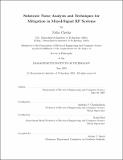Substrate noise analysis and techniques for mitigation in mixed-signal RF systems
Author(s)
Checka, Nisha, 1980-
DownloadFull printable version (3.192Mb)
Other Contributors
Massachusetts Institute of Technology. Dept. of Electrical Engineering and Computer Science.
Advisor
Anantha P. Chandrakasan.
Terms of use
Metadata
Show full item recordAbstract
Mixed-signal circuit design has historically been a challenge for several reasons. Parasitic interactions between analog and digital systems on a single die are one such challenge. Switching transients induced by digital circuits inject noise into the common substrate creating substrate noise. Analog circuits lack the large noise margins of digital circuits, thus making them susceptible to substrate voltage variations. This problem is exacerbated at higher frequencies as the effectiveness of standard isolation technique diminishes considerably. Historically, substrate noise was not a problem because each system was fabricated in its own package shielding it from such interactions. The work in this thesis spans all areas of substrate noise: generation, propagation, and reception. A set of guidelines in designing isolation structures was developed to assist designers in optimizing these structures for a particular application. Furthermore, the effect of substrate noise on two key components of the RF front end, the voltage controlled oscillator (VCO) and the low noise amplifier (LNA), was analyzed. Finally, a CAD tool (SNAT) was developed to efficiently simulate large digital designs to determine substrate noise performance. (cont.) Existing techniques have prohibitively long simulation times and are only suitable for final verification. Determination of substrate noise coupling during the design phase would be extremely beneficial to circuit designers who can incorporate the effect of the noise and re-design accordingly before fabrication. This would reduce the turn around time for circuits and prevent costly redesign. SNAT can be used at any stage of the design cycle to accurately predict (less than 12% error when compared to measurements) the substrate noise performance of any digital circuit with a large degree of computational efficiency.
Description
Thesis (Ph. D.)--Massachusetts Institute of Technology, Dept. of Electrical Engineering and Computer Science, 2005. This electronic version was submitted by the student author. The certified thesis is available in the Institute Archives and Special Collections. Includes bibliographical references (p. 151-158).
Date issued
2005Department
Massachusetts Institute of Technology. Department of Electrical Engineering and Computer SciencePublisher
Massachusetts Institute of Technology
Keywords
Electrical Engineering and Computer Science.